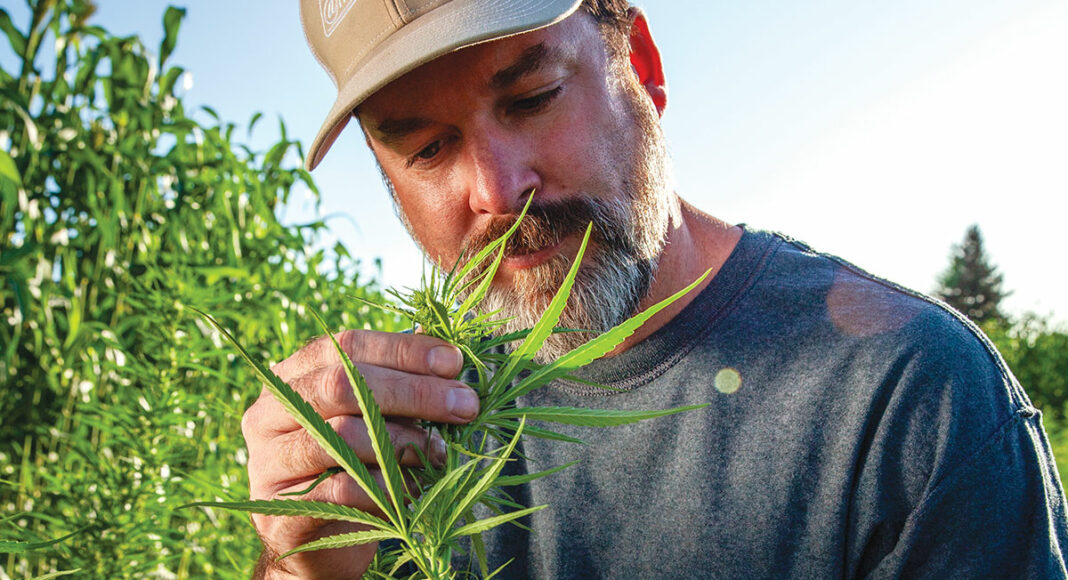To Jesse Hughes, California is the ideal place to grow hemp. Not only is the state the top producer of cannabis generally, but particularly in Sonoma County and surrounding areas, “we have the land,” Hughes says. “And the climate is perfect, as proven by our agriculture industry.”
But California lags other states, such as Colorado and Kentucky. Hughes, a hemp and CBD entrepreneur who runs the Hemp General Store in Petaluma, says one historical reason for this is that during the decades when both hemp and marijuana were illegal, it was much more lucrative to grow marijuana—which is loaded with THC, the stuff that gets you high. Local restrictions on hemp growing, even after pot was legalized, also played a role.
But now there are new problems. After hemp was legalized federally under the 2018 Farm Bill, growers flocked to the market, and now there’s a glut. Until the market evens out, it’s unlikely that much more land will be given over to hemp growing. “About 18 months ago, I was brokering hemp at $7,000 to $10,000 a kilo,” Hughes says. After the price “plummeted” late last year, the wholesale cost stabilized at about 10% of what it was then.
“There’s no incentive to grow that material, and there’s no incentive to process it,” Hughes says. “Think about it: If you grow tomatoes or corn and you have a warehouse full of hemp, what do you do with the hemp? You give it away to make room for other crops.” As it is, he says: “If I had a truckload of CBD in 2018, I’d be a millionaire now.”
The government doesn’t keep statistics on hemp, but experts say the amount of farmland devoted to hemp over the past few years has increased by about tenfold. Estimates vary widely, but Hughes thinks about 250,000 acres of farmland is taken up by hemp plants in the United States.
To the casual observer, it might seem strange that there’s a glut of hemp, given the CBD craze that was underway even before the Farm Bill was passed. CBD is a component of the cannabis plant that doesn’t get you high, but carries many potential health benefits, from relieving pain to preventing seizures to relieving insomnia, among many others (the proof for medical claims varies widely from ailment to ailment). Though it has only trace amounts of THC (less than 0.3%), hemp is rich in CBD cannabinoids, and CBD extracted from hemp is legal under federal law.
Consumers are still hungry for CBD, but the industry is hamstrung by the federal government. The Food And Drug Administration disallows the use of the substance in food and beverages, and marketers are not allowed to make any kind of health claims for the tinctures and salves that are allowed. Most observers, including Hughes, believe that such restrictions will be eased, but until then, a market that everybody thought would be going gangbusters by now has instead been stymied.
But Hughes, who runs a small operation selling hemp products and also works as a broker and marketer for the Colorado-based Hemp Depot, is optimistic. “Twenty-eight states say it’s OK to use CBD in food,” he notes. (In California, CBD-containing food and beverages may be sold only in licensed cannabis dispensaries, and those products must be made with CBD derived from pot, not from hemp). Big companies like Walgreen’s and CVS have expressed strong interest in selling CBD products, and there is room for expansion into food and beverages if a big brand like Coca-Cola gets on board.
“I think the situation would have changed already, but Covid has put a damper on all things,” Hughes says. “But now I expect serious movement by the FDA by September of 2021.”
It was with an expected boom in mind that Santa Rosa Junior College launched its Hemp Agriculture program last year, devoting about a third of an acre of its 365-acre Shone Farm to growing the plant. At the time, Benjamin Goldstein, dean of the college’s agriculture department, said he thought hemp had potential to move even some wine growers into growing hemp on their land, since the price of hemp at the time commanded prices that were “dramatically higher” per acre than wine.
The fact that the market has collapsed hasn’t diminished student interest, he says. Mainly, that’s because the skills they’re learning are essentially the same ones needed to grow pot for the medical and adult-use markets. “The techniques are very similar,” Goldstein says. “We don’t control what students do after they graduate, and if they want to go and grow pot plants, more power to them.”
Still, the situation has stymied the school’s plans to market its hemp and recover some of the costs of the program. “We’re still looking for local partners to do the extraction and marketing,” he says. “The economies of scale just don’t exist right now for big extractors.” There are several big cannabis processors in Sonoma and around the North Bay, but they are severely limited when it comes to hemp. “They’re not allowed to run hemp through their extraction machines, and the processes must be kept separate,” he says. “That would be a huge cost.” But it might prove to be worth it if prices rebound in the next few years.
Meanwhile, selling to out-of-state processors to extract the CBD from the plant means “we lose the local connection to agriculture.”
Another big loss is the marketing opportunity afforded by location. “Sonoma County is a brand,” Hughes says. “People buy wine because it’s from here. We’re purveyors of really cool shit. Why not add hemp to that?”













